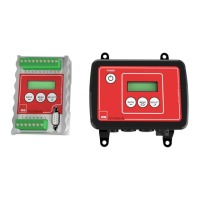AQ Elteknik AB Ultrasound Controller Manual 23
Ultrasound Controller (and screened
cable must always be used). Any
unscreened part of the cable should
be no longer than 30mm. To
minimize the risk of electric
interference it is important that
sources of interference like frequency
inverters should use screened cables
between inverter and motor. In an ex-
installation, shielding aluminum
plates must be placed outside each
group of zener barriers belonging to
each Ultrasound Controller, order
number: Ex-barriershield, see Level
Switch Ex manual.
Mounting the Level Sensor
The level sensor (= Level Switch) is
mounted under the container. It is
important the ultrasound pass as
easy as possible through the
container bottom. How well it passes
depend on the wall material and
thickness. Steel or glass bottom
1,2mm - 6 mm are ok. Plastic bottom < 15mm (PP<10mm) is ok. Plastic with fiberglass < 8mm is
ok. Testing on the actual container is recommended.
When the bottom is very thick, vibrations within the wall makes accurate measurements of low
levels difficult. Minimum level that can be measured depends on the bottom thickness and its
material. As the sound passes through the bottom it makes the bottom vibrate and these
vibrations take time to decay especially if the bottom is thick. On a 3mm thick stainless-steel-
bottom liquid levels down to 30mm can be measured.
If the bottom thickness can be chosen, a thickness with resonance at 2MHz is preferred since at
this frequency the sensor has maximum gain. For stainless steel this is approximately 1,5mm,
3mm or 4,5mm. The ultrasound beam is narrow (angle less than 10˚) so the level sensor must be
aimed in such a way that the echo from the surface is properly returned back to the level sensor.
See below what to do with a non-horizontal container bottom.
The velocity sensor (= Level Switch) is mounted on the container
wall near the bottom.
See Level Switch manual how to glue the level sensor.
In the GSF90 level and velocity sensors are combined.
Installing the level sensor on a non-horizontal
bottom
If the bottom is not horizontal or has uneven thickness, a thick
layer of silicone can be used to glue the level sensor inclined. In
this case the level sensor should be connected to Ultrasound
Controller and be active measuring while it is being glued so that it
can be adjusted for the strongest echo. A stainless steel bottom should preferably not be inclined
from horizontal more than 10˚. Fill the container more than half full and put the level sensor with
silicone between it and the bottom. If there is no error go to Level Sensor measured data. The echo
Ultrasound
Controller
Terminal
Level sensor 1 Screen
& Velocity sensor 1
Screen
Level sensor 2 Screen
& Velocity sensor 2
Screen

